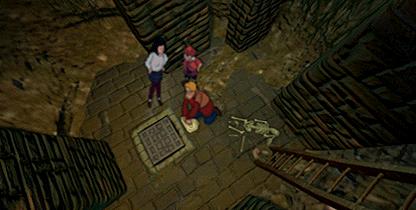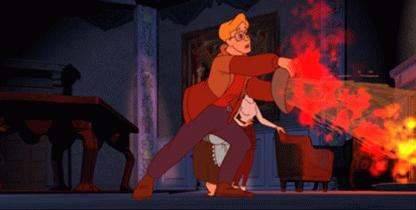

History: Trilobyte initially received accolades for their first game, 7th guest, which is still selling briskly in certain markets, with over 500,000 copies sold. Eleventh Hour initially presold 500,000, but the sales of the product flagged and only 50,000 eventually sold. This was a disaster for Trilobyte.
Summary: The new offering, Clandestiny is a departure from previous
Trilobyte games. Traditional two dimensional (2D) hand drawn animation
cells are colored and rendered on the computer over a three dimensional
(3D) Trilobyte background. These cartoon characters contain all the
elements of traditional animation figures and this combined with the 3D
worlds and scripting Trilobyte can create should give them the advantage
with this product.

The plot: Witty, sarcastic and heir to a legacy of cowardice, young Andrew MacPhiles is the unlikely hero of Clandestiny. Accompanied by his spunky, fiancée, Paula, he reluctantly answers a mysterious summons to return to Scotland and claim his ancestral home, the elegant yet creepy Castle MacPhiles. But first, he must fulfill an ancient prophesy, and defeat a deadly curse that has haunted his family for generations.
Searching the castle for clues reveals a dragon in the basement of the castle. The dragon is holding the treasure, which is mostly the honor of the MacPhiles, which Andrew must redeam, by being the first MacPhile brave enough to face his deamons and destroy them. The ending contains a charming twist on the Saint George and the dragon tale.
Game play: Successive combinations of word puzzles to open doors and fill in the components of the MacPhile crest and 7th Guest type geometry puzzles to enable the doors so that the word problems become active determine the progression of the game. The plot is linear and each opened door is accompanied by a short animated sequence that reveals the next part of the story. Most of the doors are locked and must be opened with the puzzles as the game progresses
Puzzles: Puzzles are composed of word riddles and physical puzzles, such as the sugar cube puzzle that makes you place eight sugar cubes on ten positions on an anatomical model of Andrew MacPhiles. Selecting the correct cube will eliminate it and move another cube to another anatomical location. Basically, whichever cube is "jumped" disappears from the map until only one cube remains. Another puzzle involves deciphering the water currents on a checker board so as to guide a sailing ship from one corner of the board to the sanctuary of a green island in the other corner of the board.
There are over thirty puzzles, 16 logic puzzles, 2 artificial intelligence games, and 13 door riddles. The logic puzzles are of the sliding tile, jumping pieces, cursed coins - a form of go, trade winds - a movement by current type puzzle, book shelf - spell the message puzzle, and many others which vary from insanely easy to incredibly hard. Those familiar with solving puzzles will find them easy.
The puzzles are intricately woven into the plot this time out. In the
past games 7th Guest and 11th Hour the puzzles were not really an
integral part to the game, which may have been why the public tired of
the format so quickly. The new puzzles are much better in the way that
they relate to the story line. Each room has both a door word riddle
puzzle and one logic puzzle.

Modes: The puzzle difficulty can be changed from easy (cowardly), to moderate (nervous), to hard (brave). Easy makes every puzzle start at one move from winning the game. Moderate has puzzles starting at the half finished point. While the hard setting requires that game player to solve the entire puzzle.
Interface: Getting around the game is much the same awkward affair as in the two previous games with the interactive cursor being the skeletal hand for directions of travel, the eye to get a closer look at hot spots on the screen, The pulsing brain for the puzzles, and the chattering teeth for narrative explanations. Moving around is an awkward and very rigid affair, no different from the two previous games. You move from one position to another within the 3D Studio graphics on a track with little freedom of movement. You cannot look up or down or spin around within 360 degrees as seen with many other games of this type. Movement is on a track and very little freedom of movement, which is another aspect of the game engine which is really showing its age.
There is a map which reveals the rooms of the house as Andrew explores them. The map unfortunately does not keep track of where Andrew is at any one moment, and it does not incorporate an automatic travel feature, both features would have enhanced and simplified game play immensely. Trilobyte looses points on both scores. The map which came with the reviewer’s guide, but will not be in the consumer version of the game is essential to getting you bearings while moving around.
Graphics: Are traditional 7th Guest-type 3D Studio rendered graphics with 2D classically rendered animation art suspended over the background with a resolution of 640x320 pixels and 64,000 colors or 16 million colors. The details are admirably crisp, but where the 3D graphics while exploring are letterbox and basically fill the screen from left to right, the animated sequences are in a small one-quarter screen affair with a stationary screen mat, which is extremely hard to see unless you have a 17 inch monitor.
Animation: Two dimensional animation is both incredibly smooth and incredibly small, side scrolling which is melded to the 3D rendered backgrounds. Scrolling of the 3D studio graphics is rigid and track driven and was smooth, but very restricting and difficult to use. Animations start by approaching and opening doors that have been previously locked with the word puzzles.
Clickable items provide diversion of an informative nature relating to Scottish lore, or a humorous sight gag like the fake Loch Ness monster seen out of the telescope in the tower bedroom. The sense of humor displayed in the portrayal of the cowardly hero and the other aspects of sight gags and humorous characterizations, like the elfish and toothy Fergus MacPhiles who also functions as the castle handyman and informal door keeper. Many of the characterizations are both informative and further the plot with additional information and set up humorous happenings that the game player shares.
Other devices include a book of Scottish lore within the interactive Guide Book to Scotland with a glossary of terms and explanations of Scottish legends. The book also provides hints to the word riddles and logic puzzles with four stages of progressively more specific hints. Saving games is through the snapshot feature in the photos section of the Guide Book, but I was unable to get it to work properly causing me to have to repeat a major portion of the game when it bombed.
The Guide Book contains a Lore and Sights section which expands on the notable myths and attractions of Scotland. The introduction becomes optional once you have saved a game.
Voice actors: The voice acting is professionally done with good acting all around.
Music score: A charming CD-quality, original musical movie score written by composer Mason B. Fisher signals which rooms have activities that are currently active with a different tune of music than the inactive rooms.
Sound effects include the crackle of burning fire, the whoosh of the fire’s extinguishment, the clang of arms, and others.
Future plans:
Journalists: Barry compares the game to Scooby Doo, with overacting, poorly scripted, and tacky animation.
References:
www.cheatzone.com/clandestiny/clandestiny.html
www.tbyte.com/digs/pr005.htm
Barry Brenesal, PC Games, volume 3, number 12, December, 1996, pg. 130, 92%.